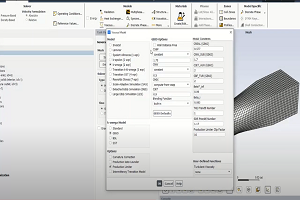-
-
March 17, 2023 at 9:00 am
 FAQParticipant
FAQParticipantThe Ogden hyperfoam model is a strain energy function which allows for large compressibility since the deviatoric and volumetric terms are actually coupled. The “beta” parameter can be related to the Poisson’s ratio as follows: For a linear elastic material: bulk_modulus = EX/3/(1-2*NUXY) shear_modulus = EX/2/(1+NUXY) Therefore, the ratio of bulk to shear modulus is: bulk/shear = 2*(1+NUXY)/(3*(1-2*NUXY)) Per the Elements Reference for Ogden Hyperfoam constants, the initial bulk and shear moduli are: initial_bulk_modulus = SUM(mu_i * alpha_i (1/3 + beta_i)) initial_shear_modulus = SUM(mu_i * alpha_i)/2 Therefore, the ratio of bulk to shear modulus is: bulk/shear = SUM(1/3+beta_i)*2 Assuming that beta_i is a constant (i.e., beta_1=beta_2=…=constant for all values of i), we can therefore relate Poisson’s ratio with beta_i: bulk/shear = 2*(1/3 + beta_i) = 2*(1+NUXY)/(3*(1-2*NUXY)) (1/3 + beta_i) * 3 * (1-2*NUXY) = (1+NUXY) -1+1+3*beta_i = NUXY + 2*NUXY + 6*NUXY*beta_i NUXY = 3*beta_i/(3+6*beta_i) NUXY = beta_i / (1+2*beta_i) Hence, for example, if beta_i = 0.5, then NUXY can be calculated as being 0.25.
-


Introducing Ansys Electronics Desktop on Ansys Cloud
The Watch & Learn video article provides an overview of cloud computing from Electronics Desktop and details the product licenses and subscriptions to ANSYS Cloud Service that are...

How to Create a Reflector for a Center High-Mounted Stop Lamp (CHMSL)
This video article demonstrates how to create a reflector for a center high-mounted stop lamp. Optical Part design in Ansys SPEOS enables the design and validation of multiple...

Introducing the GEKO Turbulence Model in Ansys Fluent
The GEKO (GEneralized K-Omega) turbulence model offers a flexible, robust, general-purpose approach to RANS turbulence modeling. Introducing 2 videos: Part 1 provides background information on the model and a...

Postprocessing on Ansys EnSight
This video demonstrates exporting data from Fluent in EnSight Case Gold format, and it reviews the basic postprocessing capabilities of EnSight.

- Question: What is the difference between PLNSOL, EPPL, EQV and PLNSOL,NL,EPEQ?
- How to use layered section to simulate composites and post process the results in ANSYS Mechanical
- Guidelines of modeling a gasket.
- ANSYS Mechanical: Delamination Analysis using Contact Debonding
- For the stress-life fatigue method, how are the Goodman and Gerber mean stress theories used to modify the calculated stress amplitude in the Workbench Fatigue Module?
- Why is the unit of the elastic foundation stiffness N/m^3?
- How do I move a material property from Engineering Data to an existing Material Library?
- Hyperelastic Simulations
- What are Isochronous stress-strain curves? How can they be used in ANSYS for modeling creep?
- How do I enter major Poisson’s ratio in ANSYS Mechanical?

© 2025 Copyright ANSYS, Inc. All rights reserved.

